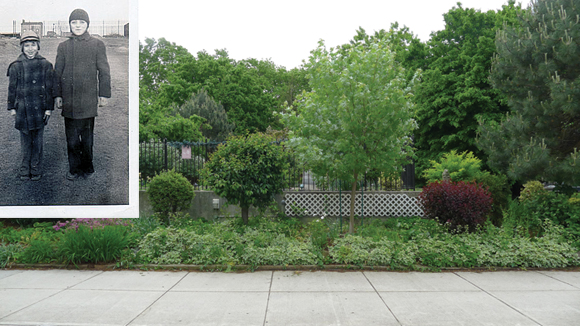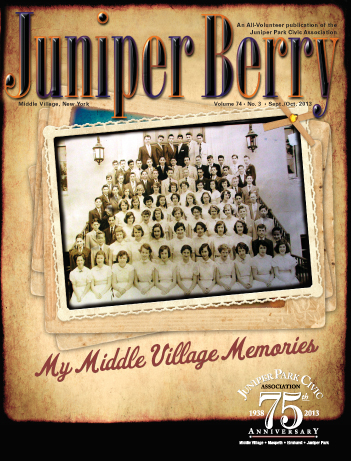Bordering Juniper Boulevard South, Dry Harbor Road, Juniper Boulevard North and 80th Street – cut off from the rest of Juniper Park – this greenspace known as Pullis Cemetery area took place around 1940.
Located at 81st Street and Juniper Boulevard North the Pullis Landmark stakes a somewhat earlier claim to Juniper’s passive East Lawn.
In 1822, Thomas Pullis, Sr., a Dutch immigrant, purchased a 32-acre farm in Middle Village, which included what is now the entire East Lawn of Juniper Park. Thomas Pullis, Sr. then created a family cemetery on his farm with the burial of a child. Pullis, Sr. died 5 May 1854, aged 76 years, and his farm was bequeathed to his three sons with the condition that this cemetery was never to be sold. In his estate, funds were provided to build a brick wall around the cemetery so that it would be protected permanently.
Pullis showed foresight. Farms and estates were broken up into small parcels of land for residential purposes. When the grid system of streets came to Queens many of the old colonial cemeteries that were left were subjected to vandalism and neglect. The Pullis Cemetery (location of the Pullis historical structure) is one of the few important ones remaining in Queens.
Juniper’s passive East Lawn has seen a few bad times over the years. In 1992, Juniper Park, then in a state of neglect, received much needed restoration and repair.
Around 1994, the Pullis plot, unlike the rest of Juniper Park, was an eyesore. Spearheaded by Ed Shusterich, a group of volunteers planted and donated flowers around the Pullis plot, improving this plot as well as the surrounding East Lawn area. This dedicated volunteer effort continues through the efforts of Franz Klampher and Peter Kusenda, adding much beauty as well as preserving a little Colonial history. With community support improvements to the East Lawn have been made, such as: surveillance cameras, drainage, and more trees. A utility building containing a water source was built adjacent to the Pullis landmark making maintenance more manageable. The building, an attractive, red brick building with outdoor lighting and a decorative weathervane, stands as a monument to the Pullis legacy.
The Pullis landmark improvements have made Middle Village an exhibit for public viewing in Queens. It is beneficial for the community and civic improvement to preserve this historical structure.
Today, take a pleasant stroll through Juniper’s passive East Lawn and it’s 1940 again: nearby, a Metropolitan Avenue trolley rolls along leisurely in a less complicated time. The timeless pleasure of relaxing in a beautiful park remains unchanged in these uncertain times.



